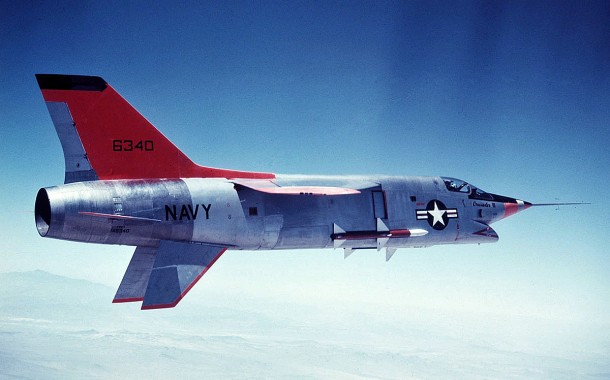
Fifty-eight years ago this month, the USN/Vought XF8U-3 Crusader III interceptor prototype took off on its maiden test flight at Edwards Air Force Base, California. Vought chief test pilot John W. Konrad was at the controls of the advanced high performance aircraft.
The Vought XF8U-3 was designed to intercept and defeat adversary aircraft. Although it bore a close external resemblance to its F8U-1 and F8U-2 forbears, the XF8U-3 was much more than just a block improvement in the Crusader line. It was considerably bigger, faster, and more capable than previous Crusaders and was in reality a new airplane.
The XF8U-3 measured 58.67 feet in length and had a wing span of an inch less than 40 feet. Gross Take-Off and empty weights tipped the scales at 38,770 lbs and 21,860 lbs, respectively. Power was provided by a single Pratt and Whitney J75-P-5A generating 29,500 lbs of sea level thrust in afterburner.
A distinctive feature of the XF8U-3 was a pair of ventrally-mounted vertical tails. These surfaces were installed to improve aircraft directional stability at high Mach number. Retracted for take-off and landing, the surfaces were deployed once the aircraft was in flight.
The No. 1 XF8U-3 (S/N 146340) first flew on Monday, 02 June 1958 at Edwards Air Force, California. Vought chief test pilot John W. Konrad did the first flight piloting honors. The aircraft flew well with no major discrepancies reported. Approach and landing back at Edwards were uneventful.
Subsequent flight testing verified that the XF8U-3 was indeed a hot airplane. The type reached a top speed of Mach 2.39 and could have flown faster had its canopy had been designed for higher temperatures. The flight test-determined absolute altitude of 65 KFT was exceeded by 25 KFT in a zoom climb.
Those who flew the XF8U-3 said that the aircraft was a real thrill to fly. The Crusader III displayed outstanding acceleration, maneuverability and high-speed flight stability. Control harmony in pitch, yaw, and roll was extremely good as well.
Despite its great promise, the XF8U-3 never proceeded to production. This was primarily the result of coming up short in a head-to-head competition with the McDonnell F4H-1 Phantom II during the second half of 1958. While the Crusader was faster and more maneuverable than the Phantom, the latter’s mission capability and payload capacity were better.
Most historical records indicate that a total of five (5) Crusader III airframes were built. The serial numbers assigned by the Navy were 146340, 146341, 147085, 147086, and 147087. None of these aircraft exist today.
